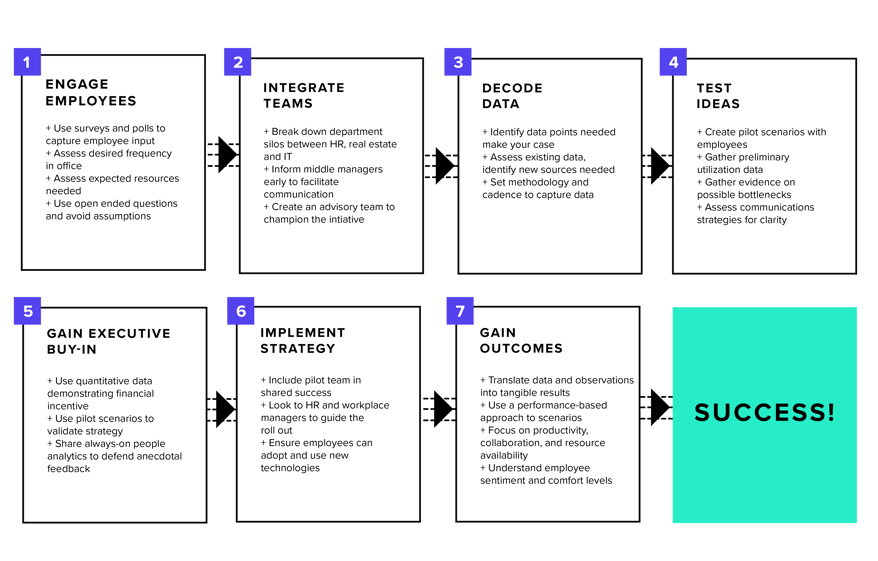Change Management: How to Plan and Pitch a Dynamic Office
Nearly 60 percent of employees will return to a physical workplace, according to recent stats from the International Data Corporation (IDC). Still, as with all the uncertainties faced by businesses set to emerge from a pandemic, it’s not clear how often those people will actually be onsite.
At the IDC Directions 2021 conference in March, attendees heard what’s coming for workplace management priorities: complying with health and safety requirements; supporting workers from any location, and reconfiguring offices around collaboration.
This new office paradigm demands a thoughtful approach. It is imperative for business owners to consider their commercial real estate space: how it’s used, maintained, and the experience of those working inside it. All answers are ultimately rooted in data.
Managing change in the new work paradigm
 We recently spoke with Martin Hofmann of Oversea Strategies, who has seen first-hand how companies are shoring up internal communications, change management and workplace experience personnel in order to help sort out this new paradigm.
We recently spoke with Martin Hofmann of Oversea Strategies, who has seen first-hand how companies are shoring up internal communications, change management and workplace experience personnel in order to help sort out this new paradigm.
“Change management can’t be an afterthought,” says Martin. “It has to be built purposefully and strategically to help uncover pain points and opportunities, generate proof points to sway executives, get employees on board, and then ensure the plan works as intended.
“You can devise the office of the future – but you have to get people to that future,” he adds. “Most importantly, that requires data, not just good intentions.”

Tips on planning and managing a changing workplace
Source information, engage employees, design and test the future, and secure final buy-in for a long term strategy. That is the road to travel for pandemic-level change management. Here, according to Martin, are the considerations to make along the way:
Engage employees: Don’t ignore the classic change management tool of questionnaires and surveys: if a company’s future is tied to greater employee freedom and responsibility, get their opinions up front. It’s too easy to make assumptions and create flawed strategies. Martin says one major company prior to COVID shifted from cubicles to open concept without doing surveys. While they designed a nice modern office with plenty of amenities, many employees were unhappy and felt, for instance, that they had to scramble each day to get their favorite spot to work.
Build a people-centric strategy early: Surprisingly, the people most affected by change are often left out of strategic discussions. Break out of department siloes and inform middle managers early across the business. It seems simple, but this crucial step is often ignored, which can lead to a lack of trust and poor morale. In addition to tools like employee surveys, consider putting together an advisory board with employees from all levels of the company to gut check ideas and approach.
Decode what you need to get the data: To develop and defend new change management strategies, you need data – particularly if executives must green-light any new investments. Martin says that indoor location technology like InnerSpace can inform how people will use a space, and thus decisions on that space. Key here is to understand what you need to make the case for a new strategy and what methods you need to capture the data to prove it. Occupancy and utilization data is a prime part of the toolkit – reliably demonstrating exactly how a workspace or meeting room or pod or zone is being used, flagging new or returning visitors.
“This is relatively new thinking for executives and HR leaders,” Martin said. “There is a comfort level that must be gained, and you must decide how to prove the ROI.”
Run a pilot: Now is actually the best time to test new ideas, with offices still largely empty. For example, you could invite a select group back to an office floor (with proper safety measures in place) to gather preliminary data on how people best use the space. Gather evidence around possible bottlenecks, how much time people spend in certain areas, and where they prefer to work to inform new design decisions, resource investments, and overarching policies.
“By inviting employees into a test environment, you can gather some initial proof points, while engaging employees in a collaborative, meaningful exercise,” Martin says.
Define what productivity means now: In the re-entry to the office, companies will need to re-define what productivity now means too. We’ve learned from the virtual office experience that it’s not solely about time spent in front of a computer. In a flex world, it’s ideal to pursue a performance-based approach in understanding productivity levels – a subject that the C suite will be most interested in.
Gain executive buy-in: While qualitative feedback and anecdotal evidence hold value, executives will react most strongly to quantitative data that demonstrates an imperative to change. Case studies of similar organizations who have imparted change successfully is a good first step; data driven results from your own pilot projects, even better. Indoor location data can demonstrate how employees are actually engaging and working in the office, which builds the case for gaining executive buy-in on space optimization and employee engagement.
Cue long-term strategy: With the pieces in place to make an office smarter and a workforce more flexible, make sure the plan is set up to succeed. Martin says that failures tend to happen if employees aren’t prepared to perform in the new environment. It’s up to HR and workplace experience managers to guide the way, to ensure employees understand how to adopt and use new technologies like indoor location platforms or new smart software to enable collaboration. This is where the people-centered strategy comes full circle.
“One step that often gets missed is having middle management, team leads and supervisors, drive the change,” Martin says. “People want to hear from their immediate supervisors. A long term strategy is built on training and upskilling managers, so by empowering them to lead any major shift in work you can rely on them inspiring their respective teams.”
Change management is not a project but a program, one that needs to be launched with purpose and impact – and monitored over time. Capturing and analyzing data in the months and years to come … and course correcting along the way.
For more from Martin on how change management can support the Future of Work(place), download our latest guide.
Accurate space utilization data through Wi-Fi?
We'll prove it to you.
See why industry leaders leverage InnerSpace to generate valuable insights that go beyond occupancy.



